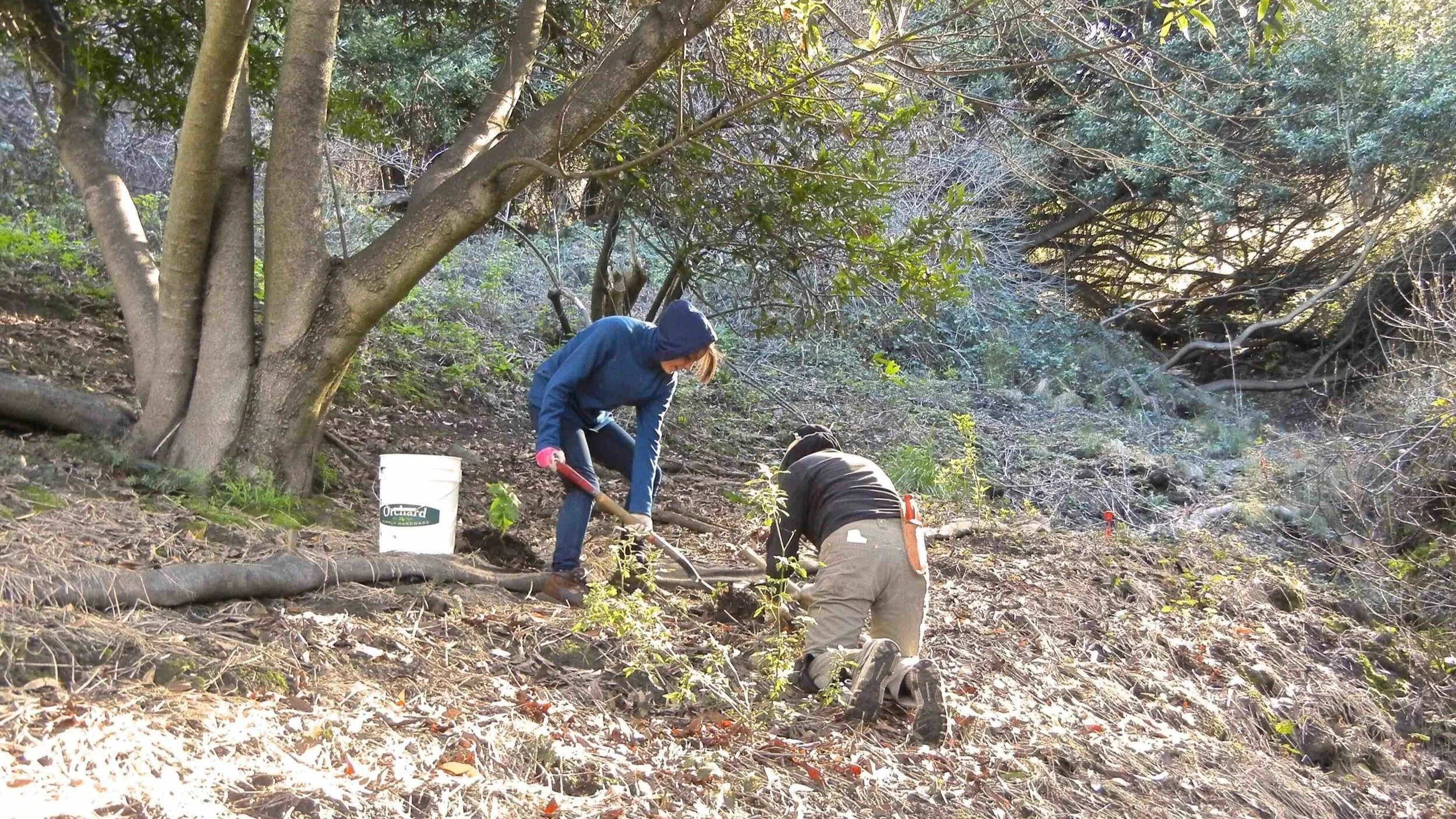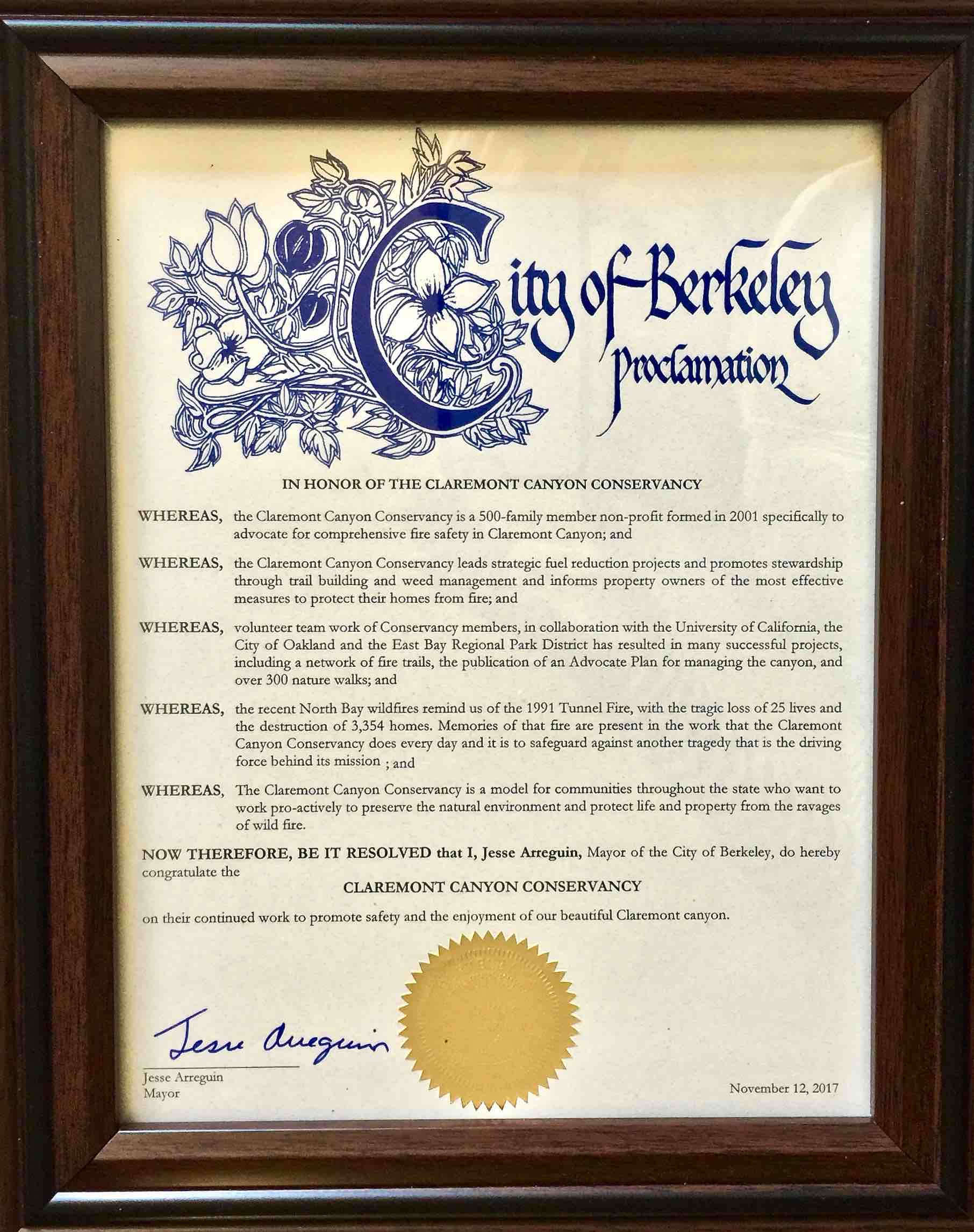Members of the conservancy’s board of directors spent much of the past summer working with UC Berkeley Forestry Professor Emeritus Joe McBride developing a plan to manage vegetation in Strawberry and Claremont canyons. I am pleased to report that Joe’s plan is now available at www.claremontcanyon.org/fuel-management-proposal. We urge UC to follow the plan as it is the standard for how to minimize the damage of a future wildfire.
Introducing the Oakland community preparedness and response program by Doug Mosher
In light of continued wildfire and earthquake disaster threats to Oakland, the Oakland Firesafe Council has begun a new program called Oakland Community Preparedness and Response (OCPR). The program, which launched in September, will help citizens and groups in the Oakland hills and foothills—both high- risk areas due to the “very high-hazard wild fire zone” at the Wildland-Urban Interface and the 120-mile-long major earthquake zone along the Hayward Fault—to prepare for these threats. The goal is to bring about fewer injuries and deaths and lower financial losses in the event of a major disaster, such as a wild re or earthquake.
Summer update, by Jon Kaufman
Conservancy volunteers were busy in June and July working on the trails in our canyon, while efforts to make us safer from wildfire were moving forward at UC, in Oakland, and in Sacramento.
In June, our volunteers relocated a small section of the Willow Trail, where it had become a seasonal creek, and a little further up the trail moved a creek crossing where erosion had begun to weaken one of the corners.
Slide show chronicles wildfire history in East Bay Hills, by Jerry Kent
Click on the image for a self-guided slide show. Contact us for a presentation with this slide show.
President's Message, by Jon Kaufman
At its March meeting, the Conservancy Board of Directors elected new officers—including Marilyn Goldhaber as Vice President, Nancy Mueller as Secretary, Kay Loughman as Treasurer, and myself as President. Tim led this organization with dedication and a steady hand for much of the past 18 years. Fortunately, we are not saying goodbye to Tim; he will remain on the board as a member-at-large.
I begin my term with a shout-out to retiring president Tim Wallace.
Oakland reconsiders vegetation management in biennial budget, by Elizabeth K. Stage
Oakland’s current $4 million funding level for vegetation management, for which the Conservancy and other local organizations lobbied hard, will need our support again soon. In February, the city’s finance director, Katano Kasaine, told the City Council that these funds, to be spread over two years, were a “onetime appropriation” and thus were not included in the baseline budget.
UC awarded $3.6 million grant for its Hill Campus by Jerry Kent
After more than a decade of disappointments in its failure to obtain funding to assist with vegetation management and wildfire protection, the University of California is once again hopeful as it has been awarded a $3.6 million grant from Cal Fire.
UC’s Grant Proposal to Cal Fire: The University of California at Berkeley proposes to treat vegetation in 250 acres in its Hill Campus (upper parts of Strawberry and Claremont canyons) to reduce wildfire hazard to its buildings and nearby homes, targeting areas forested with “flammable eucalyptus and high fuel volume.” UC will also create defensible space within 100 feet of roads, fire-trails, buildings, and homes and increase the reliability of the 150 KV transmission line that supplies power the campus and Lawrence Berkeley National Laboratory.
Survey of members–summary of findings, by Marilyn Goldhaber
Members Tell Us What They Think - Summary of findings from 2018 Survey (click here to download tabulations).
On November 12, 2018 we began an online survey of members and friends of the Claremont Canyon Conservancy for whom we had email addresses (N=523). We followed up three weeks later by a mailing to non-respondents and additional member households for whom we did not have email addresses. By the close of our survey in January, 2019, a total of 180 persons responded, either electronically (N=105) or by sending in their survey through the mail (N=65).
The failure of planning to address the urban interface and intermix fire-hazard problems in the San Francisco Bay Area, by Joe McBride and Jerry Kent
(Article originally appeared in the International Journal of Wildland Fire, January 7, 2019. Reprinted here with permission from the authors.)
(Many recommendations) for fuel mitigation and architectural changes have not been addressed. In spite of the recommendations for fuel management put forth in more than 30 plans since 1923, no region-wide action has taken place. Individual agencies and local Fire Safe Councils have, in part, followed up on recommendations for fuel management on land they administer, but often a complete adoption of recommendations has not taken place. The failure to enact all of the recommendations of these is due to various combinations of the following reasons:
Wildland-urban interface fire prevention: who is in charge? by Jon Kaufman
PG&E’s community wildfire safety program by Robert Sieben, MD
FEMA update on grant to UC
Directly across the road from Signpost 29 (center of photo) are the remaining eucalyptus slated for removal on UC land in Claremont Canyon. UC is currently negotiating with FEMA to get funds returned so their wildfire safety program can move forward. Trees seen along the ridgeline (top of photo) are on EBMUD property. These are being thinned over time as an alternative to complete removal. (Note: As of December 2019, grant funds to UC were withdrawn by FEMA. Similarly-sized grant funds were subsequently provided to UC by CalFire.
Conservancy's response to Oakland's Draft Vegetation Management Plan (click below to read full document)
Living up to our commitment, by L. Tim Wallace
The Conservancy is busy on several fronts—living up to our commitment to be vigilant about wildfire safety while encouraging a healthy native environment in Claremont Canyon. Unfortunately, wildfire danger continues to be a major issue as fire season is becoming a year round concern. Public agencies are unable to devote the financial and human resources necessary to address it.
UC in mediation with FEMA to recover funds, by Jerry Kent
The Conservancy has previously reported its full support of UC Berkeley’s efforts to recover funding granted in 2015 by the Federal Emergency Management Agency (FEMA). The grants were to reduce fire danger on UC's hill campus in Claremont and Strawberry canyons by removing stands of hazardous trees.
City of Berkeley Proclamation, read by Mayor Jesse Arreguin and Council Member Susan Wengraf
Grizzly Peak and ridge fire potential, by Jerry Kent
Annual Meeting Speaker Robert Doyle, General Manager of the East Bay Regional Park District
Robert Doyle, General Manager East Bay Regional Park District
General Manager Robert Doyle began his park career over 40 years ago as a member of the East Bay Regional Park District’s eucalyptus crews, following the big freeze of 1972. He went on to serve in several eld, planning, and administrative positions before becoming Assistant General Manager for Land Acquisition and Planning in 1990. For the next 21 years he led the District’s expansion of parklands to serve the rapidly growing populations of Alameda and Contra Costa counties. In 2010, he was appointed General Manager by the Park District’s seven-member, elected Board of Directors to oversee 70 regional parks totaling 124,000 acres, 1,200 miles of interconnecting trails, and a staff of 1,000 employees.
Annual Meeting Speaker Ken Pimlott, Director of CAL FIRE
Chief Ken Pimlott was appointed Director of CAL FIRE by Governor Jerry Brown in 2011 after an outstanding, 30-year long career in state re protection programs. As Chief of CAL FIRE and also California’s State Forester, Mr. Pimlott is responsible for 237 fire stations, 39 conservation camps, 12 air attack, and 10 helitack bases.
Tom Klatt writes to Councilmember Susan Wengraf
"I attended the 8/2/2017 fire Oakland Hills fire scene during operations today and observed conditions and took photos. The City of Berkeley Fire responded, as did many other agencies. The fire would have threatened Berkeley, except that the winds were blowing onshore from the ocean. Imagine if the winds were blowing down the canyon (off-shore), as we see during Diablo Wind condition days. The most effective response came from helicopter water drops, taken from lake Anza, by EBRPD, Cal Fire and other attending helicopters. Most of the firefighters stayed on Grizzly Peak, as the hills are too steep and littered with dead eucalyptus and pine fuel."




